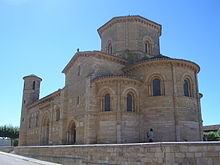
Back عمارة رومانسكية في إسبانيا Arabic Arquiteutura románica n'España AST Arquitectura románica en España Spanish Architektura romańska w Hiszpanii Polish Arquitetura românica em Espanha Portuguese
This article includes a list of general references, but it lacks sufficient corresponding inline citations. (November 2012) |



Romanesque architecture in Spain is the architectural style reflective of Romanesque architecture, with peculiar influences both from architectural styles outside the Iberian peninsula via Italy and France as well as traditional architectural patterns from within the peninsula. Romanesque architecture was developed in and propagated throughout Europe for more than two centuries, ranging approximately from the late tenth century until the thirteenth century.
During the eighth century, though Carolingian Renaissance extended its influence to Christian Western Europe, Christian Spain remained attached to the traditional Hispano-Roman and Gothic culture, without being influenced by European cultural movements, until the arrival of the Romanesque.
Romanesque architecture spread throughout the entire northern half of Spain, reaching as far as the Tagus river, at the height of the Reconquista and Repoblación, movements which greatly favored the Romanesque development. The First Romanesque style spread from Lombardy to the Catalan region via the Marca Hispánica, where it was developed and from where it spread to the rest of the peninsula with the help of the Camino de Santiago and the Benedictine monasteries. Its mark was left especially on religious buildings (e.g., cathedrals, churches, monasteries, cloisters, chapels) which have survived into the twenty-first century. Also, civil monuments (bridges, palaces, castles, walls and towers) were also built in this style.